Abstract
N-acetylcysteine (NAC) is a nonspecific antioxidant that selectively inhibits acute fatigue of rodent skeletal muscle stimulated at low (but not high) tetanic frequencies and that decreases contractile function of unfatigued muscle in a dose-dependent manner. The present experiments test the hypothesis that NAC pretreatment can inhibit acute muscular fatigue in humans. Healthy volunteers were studied on two occasions each. Subjects were pretreated with NAC 150 mg/kg or 5% dextrose in water by intravenous infusion. The subject then sat in a chair with surface electrodes positioned over the motor point of tibialis anterior, an ankle dorsiflexor of mixed-fiber composition. The muscle was stimulated to contract electrically (40-55 mA, 0.2-ms pulses) and force production was measured. Function of the unfatigued muscle was assessed by measuring the forces produced during maximal voluntary contractions (MVC) of ankle dorsiflexor muscle groups and during electrical stimulation of tibialis anterior at 1, 10, 20, 40, 80, and 120 Hz (protocol 1). Fatigue was produced using repetitive tetanic stimulations at 10 Hz (protocol 1) or 40 Hz (protocol 2); intermittent stimulations subsequently were used to monitor recovery from fatigue. The contralateral leg then was studied using the same protocol. Pretreatment with NAC did not alter the function of unfatigued muscle; MVC performance and the force-frequency relationship of tibialis anterior were unchanged. During fatiguing contractions stimulated at 10 Hz, NAC increased force output by approximately 15% (P < 0.0001), an effect that was evident after 3 min of repetitive contraction (P < 0.0125) and persisted throughout the 30-min protocol. NAC had no effect on fatigue induced using 40 Hz stimuli or on recovery from fatigue. N-acetylcysteine pretreatment can improve performance of human limb muscle during fatiguing exercise, suggesting that oxidative stress plays a causal role in the fatigue process and identifying antioxidant therapy as a novel intervention that may be useful clinically.
Full text
PDF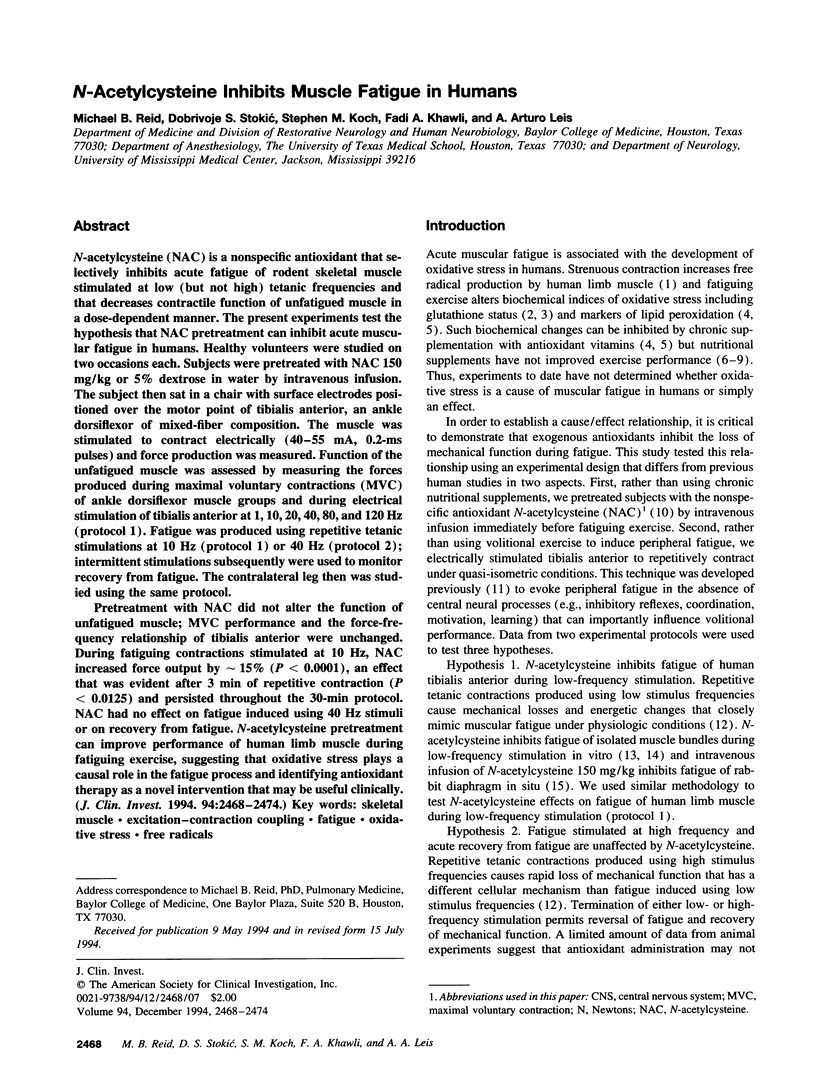
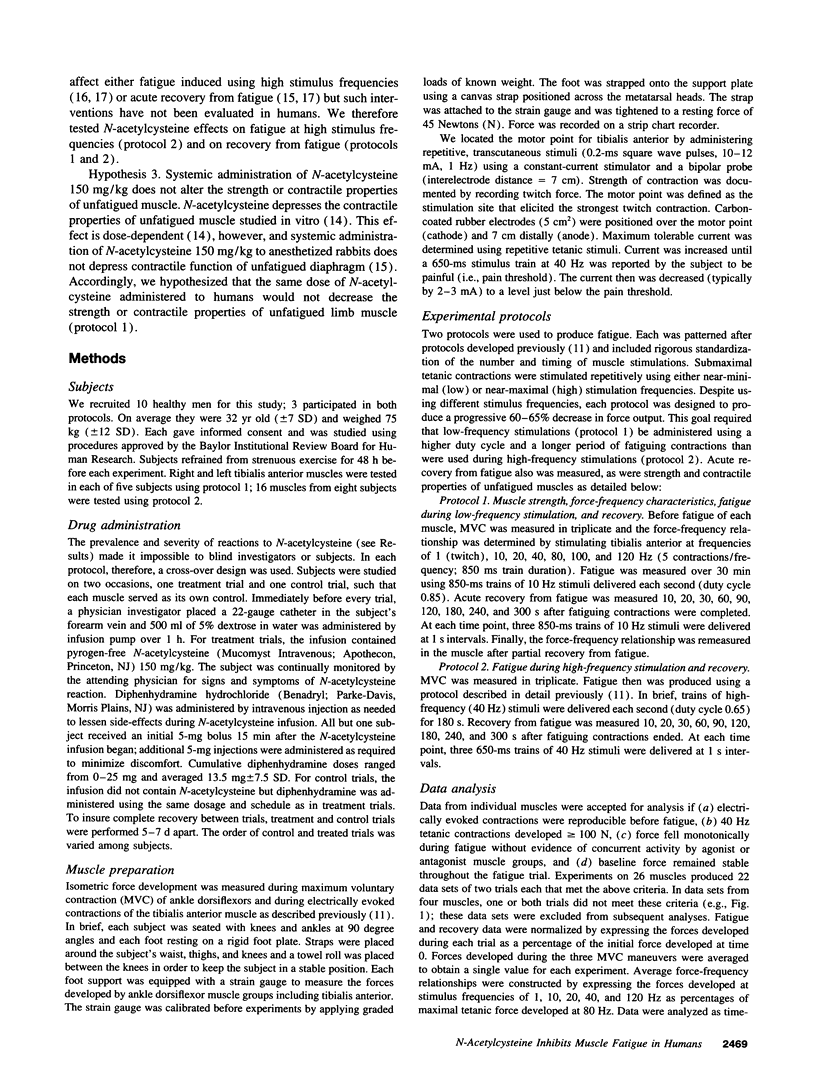
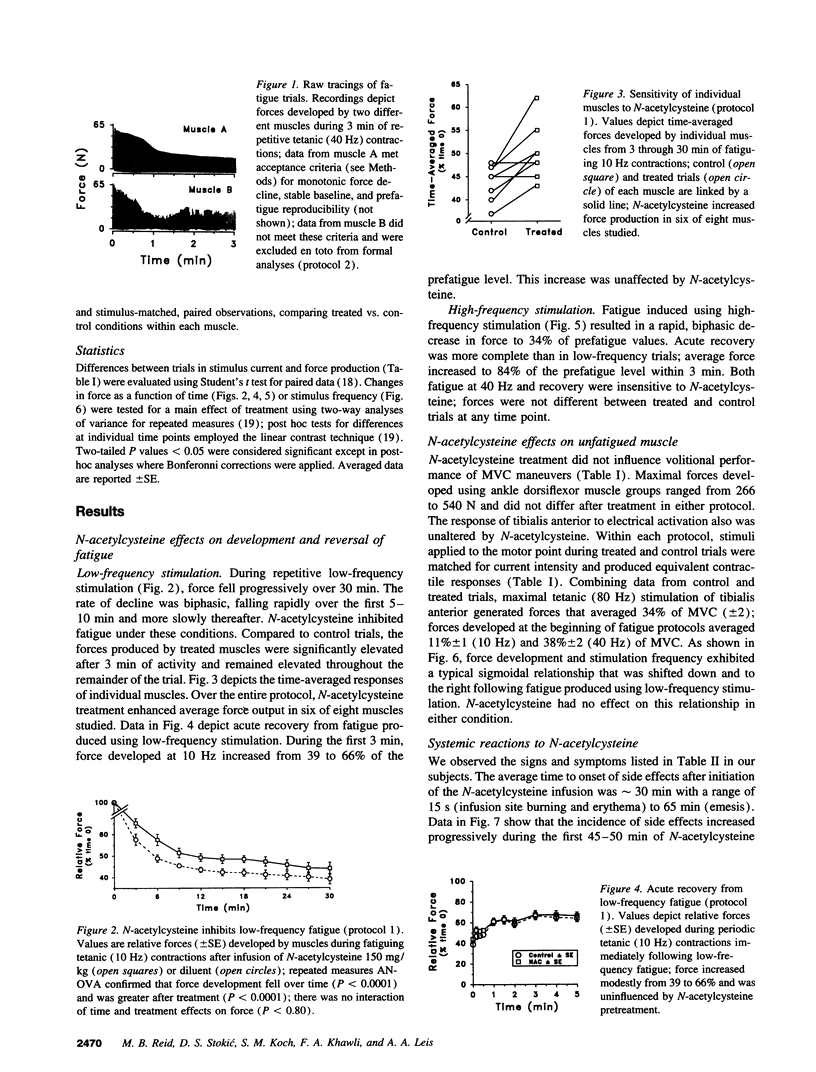
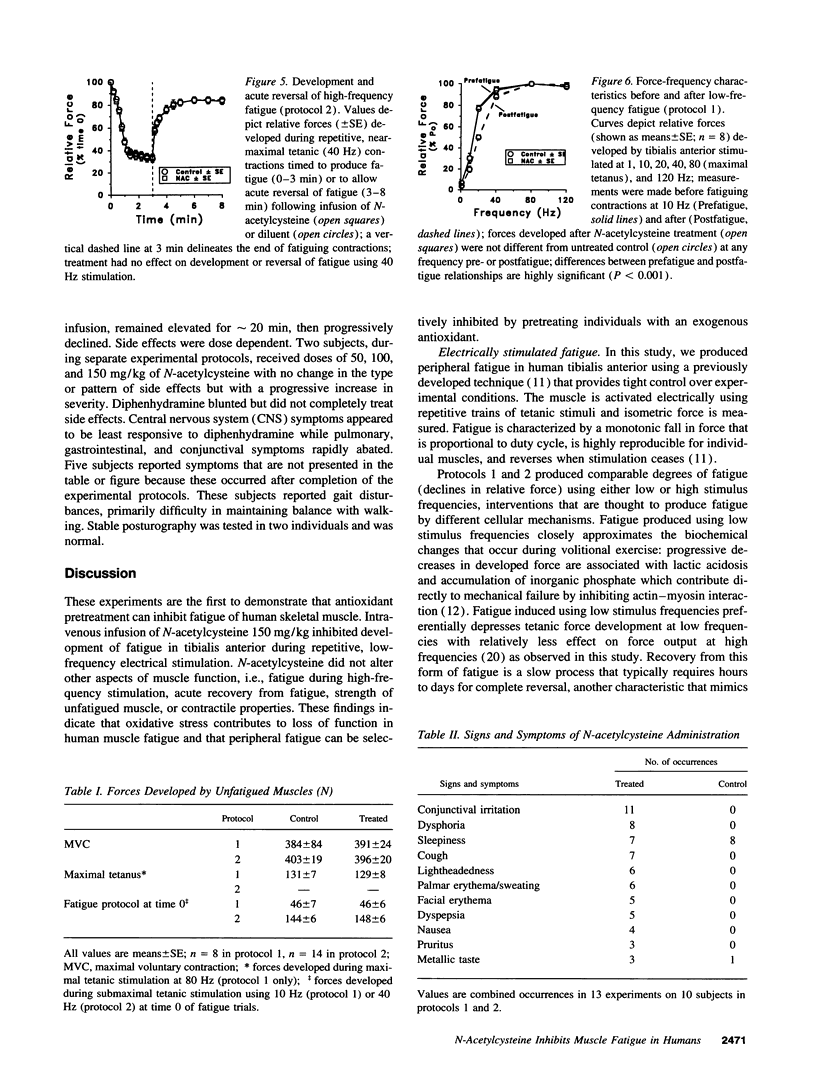
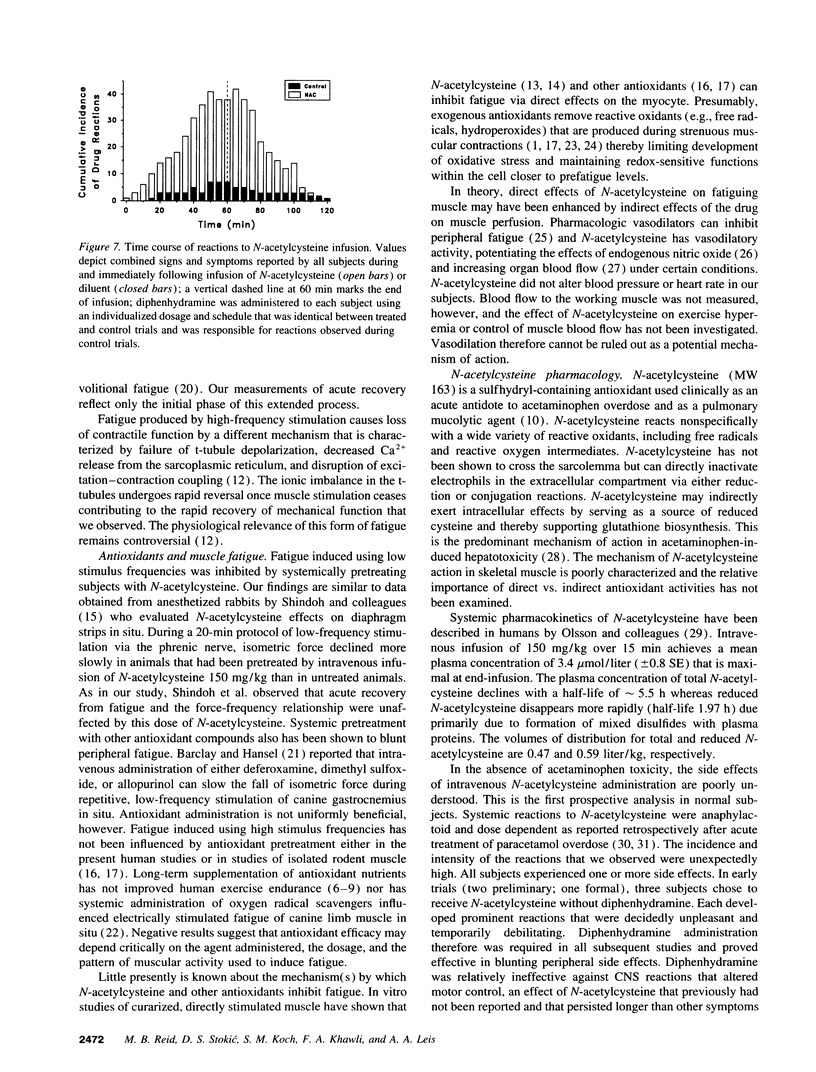
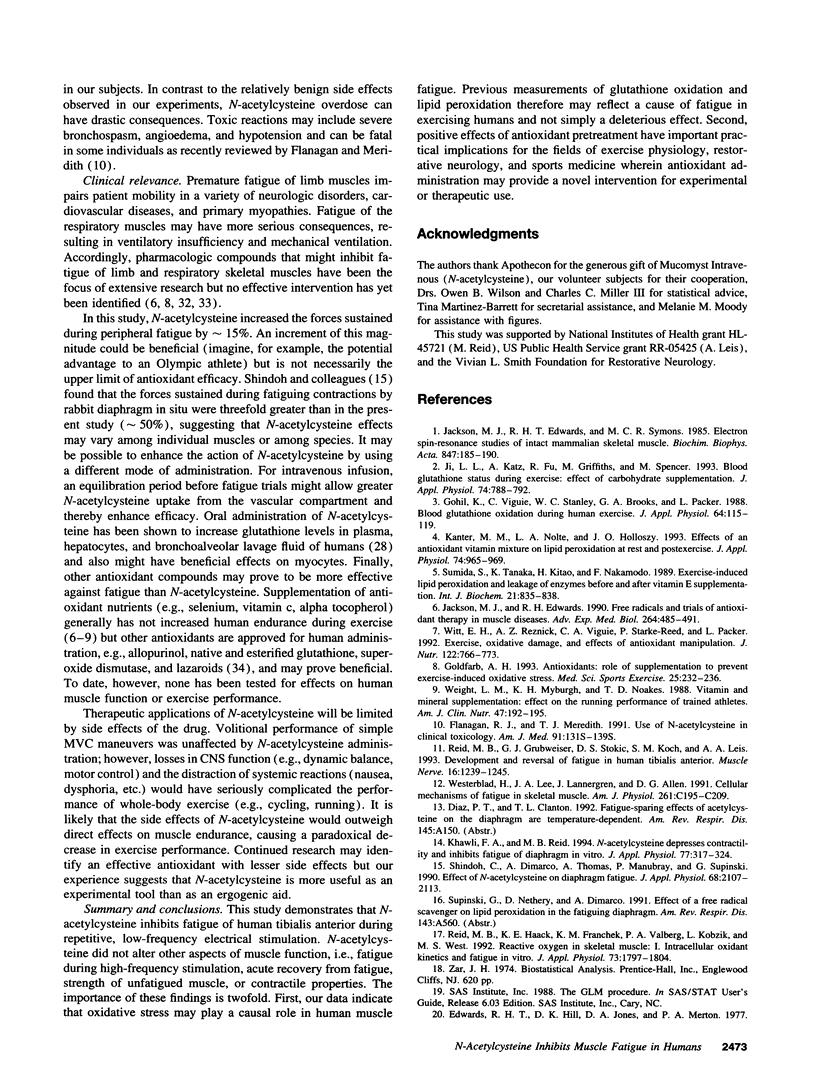
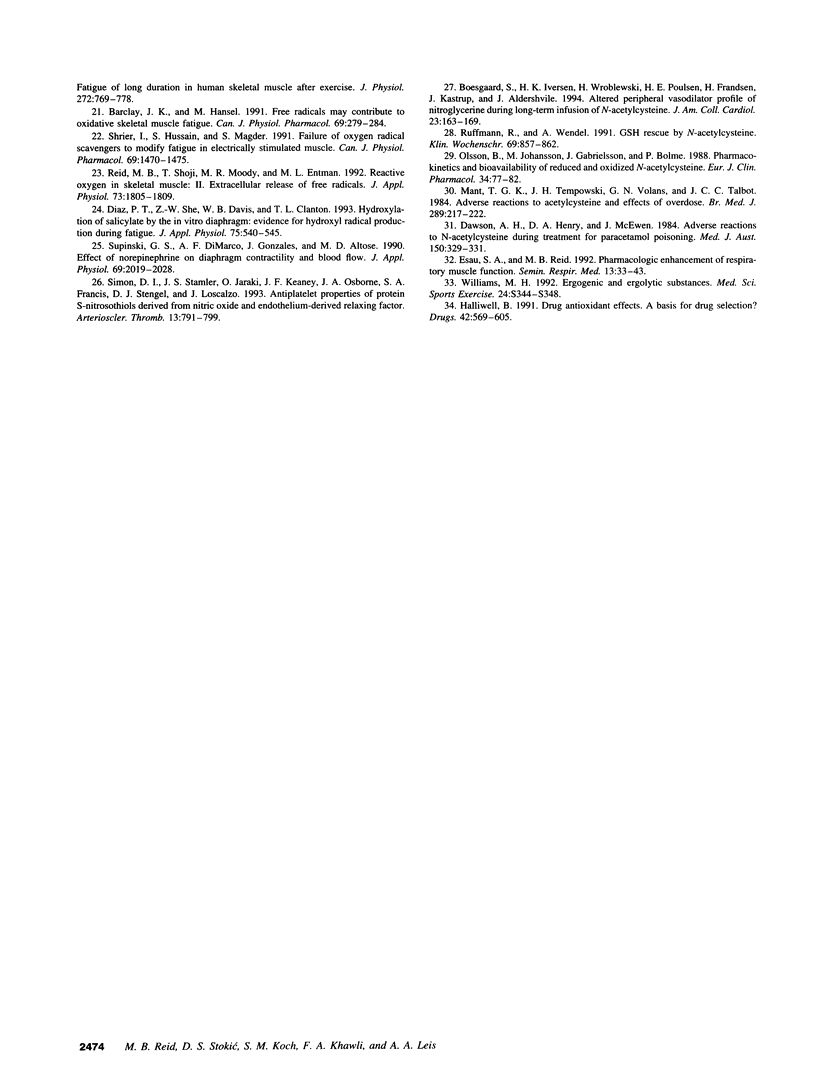
Selected References
These references are in PubMed. This may not be the complete list of references from this article.
- Barclay J. K., Hansel M. Free radicals may contribute to oxidative skeletal muscle fatigue. Can J Physiol Pharmacol. 1991 Feb;69(2):279–284. doi: 10.1139/y91-043. [DOI] [PubMed] [Google Scholar]
- Boesgaard S., Iversen H. K., Wroblewski H., Poulsen H. E., Frandsen H., Kastrup J., Aldershvile J. Altered peripheral vasodilator profile of nitroglycerin during long-term infusion of N-acetylcysteine. J Am Coll Cardiol. 1994 Jan;23(1):163–169. doi: 10.1016/0735-1097(94)90515-0. [DOI] [PubMed] [Google Scholar]
- Dawson A. H., Henry D. A., McEwen J. Adverse reactions to N-acetylcysteine during treatment for paracetamol poisoning. Med J Aust. 1989 Mar 20;150(6):329–331. doi: 10.5694/j.1326-5377.1989.tb136496.x. [DOI] [PubMed] [Google Scholar]
- Diaz P. T., She Z. W., Davis W. B., Clanton T. L. Hydroxylation of salicylate by the in vitro diaphragm: evidence for hydroxyl radical production during fatigue. J Appl Physiol (1985) 1993 Aug;75(2):540–545. doi: 10.1152/jappl.1993.75.2.540. [DOI] [PubMed] [Google Scholar]
- Edwards R. H., Hill D. K., Jones D. A., Merton P. A. Fatigue of long duration in human skeletal muscle after exercise. J Physiol. 1977 Nov;272(3):769–778. doi: 10.1113/jphysiol.1977.sp012072. [DOI] [PMC free article] [PubMed] [Google Scholar]
- Flanagan R. J., Meredith T. J. Use of N-acetylcysteine in clinical toxicology. Am J Med. 1991 Sep 30;91(3C):131S–139S. doi: 10.1016/0002-9343(91)90296-a. [DOI] [PubMed] [Google Scholar]
- Gohil K., Viguie C., Stanley W. C., Brooks G. A., Packer L. Blood glutathione oxidation during human exercise. J Appl Physiol (1985) 1988 Jan;64(1):115–119. doi: 10.1152/jappl.1988.64.1.115. [DOI] [PubMed] [Google Scholar]
- Goldfarb A. H. Antioxidants: role of supplementation to prevent exercise-induced oxidative stress. Med Sci Sports Exerc. 1993 Feb;25(2):232–236. [PubMed] [Google Scholar]
- Halliwell B. Drug antioxidant effects. A basis for drug selection? Drugs. 1991 Oct;42(4):569–605. doi: 10.2165/00003495-199142040-00003. [DOI] [PMC free article] [PubMed] [Google Scholar]
- Jackson M. J., Edwards R. H. Free radicals and trials of antioxidant therapy in muscle diseases. Adv Exp Med Biol. 1990;264:485–491. doi: 10.1007/978-1-4684-5730-8_74. [DOI] [PubMed] [Google Scholar]
- Jackson M. J., Edwards R. H., Symons M. C. Electron spin resonance studies of intact mammalian skeletal muscle. Biochim Biophys Acta. 1985 Nov 20;847(2):185–190. doi: 10.1016/0167-4889(85)90019-9. [DOI] [PubMed] [Google Scholar]
- Ji L. L., Katz A., Fu R., Griffiths M., Spencer M. Blood glutathione status during exercise: effect of carbohydrate supplementation. J Appl Physiol (1985) 1993 Feb;74(2):788–792. doi: 10.1152/jappl.1993.74.2.788. [DOI] [PubMed] [Google Scholar]
- Kanter M. M., Nolte L. A., Holloszy J. O. Effects of an antioxidant vitamin mixture on lipid peroxidation at rest and postexercise. J Appl Physiol (1985) 1993 Feb;74(2):965–969. doi: 10.1152/jappl.1993.74.2.965. [DOI] [PubMed] [Google Scholar]
- Khawli F. A., Reid M. B. N-acetylcysteine depresses contractile function and inhibits fatigue of diaphragm in vitro. J Appl Physiol (1985) 1994 Jul;77(1):317–324. doi: 10.1152/jappl.1994.77.1.317. [DOI] [PubMed] [Google Scholar]
- Mant T. G., Tempowski J. H., Volans G. N., Talbot J. C. Adverse reactions to acetylcysteine and effects of overdose. Br Med J (Clin Res Ed) 1984 Jul 28;289(6439):217–219. doi: 10.1136/bmj.289.6439.217. [DOI] [PMC free article] [PubMed] [Google Scholar]
- Olsson B., Johansson M., Gabrielsson J., Bolme P. Pharmacokinetics and bioavailability of reduced and oxidized N-acetylcysteine. Eur J Clin Pharmacol. 1988;34(1):77–82. doi: 10.1007/BF01061422. [DOI] [PubMed] [Google Scholar]
- Reid M. B., Grubwieser G. J., Stokic D. S., Koch S. M., Leis A. A. Development and reversal of fatigue in human tibialis anterior. Muscle Nerve. 1993 Nov;16(11):1239–1245. doi: 10.1002/mus.880161115. [DOI] [PubMed] [Google Scholar]
- Reid M. B., Haack K. E., Franchek K. M., Valberg P. A., Kobzik L., West M. S. Reactive oxygen in skeletal muscle. I. Intracellular oxidant kinetics and fatigue in vitro. J Appl Physiol (1985) 1992 Nov;73(5):1797–1804. doi: 10.1152/jappl.1992.73.5.1797. [DOI] [PubMed] [Google Scholar]
- Reid M. B., Shoji T., Moody M. R., Entman M. L. Reactive oxygen in skeletal muscle. II. Extracellular release of free radicals. J Appl Physiol (1985) 1992 Nov;73(5):1805–1809. doi: 10.1152/jappl.1992.73.5.1805. [DOI] [PubMed] [Google Scholar]
- Ruffmann R., Wendel A. GSH rescue by N-acetylcysteine. Klin Wochenschr. 1991 Nov 15;69(18):857–862. doi: 10.1007/BF01649460. [DOI] [PMC free article] [PubMed] [Google Scholar]
- Shindoh C., DiMarco A., Thomas A., Manubay P., Supinski G. Effect of N-acetylcysteine on diaphragm fatigue. J Appl Physiol (1985) 1990 May;68(5):2107–2113. doi: 10.1152/jappl.1990.68.5.2107. [DOI] [PubMed] [Google Scholar]
- Shrier I., Hussain S., Magder S. Failure of oxygen radical scavengers to modify fatigue in electrically stimulated muscle. Can J Physiol Pharmacol. 1991 Oct;69(10):1470–1475. doi: 10.1139/y91-220. [DOI] [PubMed] [Google Scholar]
- Simon D. I., Stamler J. S., Jaraki O., Keaney J. F., Osborne J. A., Francis S. A., Singel D. J., Loscalzo J. Antiplatelet properties of protein S-nitrosothiols derived from nitric oxide and endothelium-derived relaxing factor. Arterioscler Thromb. 1993 Jun;13(6):791–799. doi: 10.1161/01.atv.13.6.791. [DOI] [PubMed] [Google Scholar]
- Sumida S., Tanaka K., Kitao H., Nakadomo F. Exercise-induced lipid peroxidation and leakage of enzymes before and after vitamin E supplementation. Int J Biochem. 1989;21(8):835–838. doi: 10.1016/0020-711x(89)90280-2. [DOI] [PubMed] [Google Scholar]
- Supinski G. S., DiMarco A. F., Gonzalez J., Altose M. D. Effect of norepinephrine on diaphragm contractility and blood flow. J Appl Physiol (1985) 1990 Dec;69(6):2019–2028. doi: 10.1152/jappl.1990.69.6.2019. [DOI] [PubMed] [Google Scholar]
- Weight L. M., Myburgh K. H., Noakes T. D. Vitamin and mineral supplementation: effect on the running performance of trained athletes. Am J Clin Nutr. 1988 Feb;47(2):192–195. doi: 10.1093/ajcn/47.2.192. [DOI] [PubMed] [Google Scholar]
- Westerblad H., Lee J. A., Lännergren J., Allen D. G. Cellular mechanisms of fatigue in skeletal muscle. Am J Physiol. 1991 Aug;261(2 Pt 1):C195–C209. doi: 10.1152/ajpcell.1991.261.2.C195. [DOI] [PubMed] [Google Scholar]
- Williams M. H. Ergogenic and ergolytic substances. Med Sci Sports Exerc. 1992 Sep;24(9 Suppl):S344–S348. [PubMed] [Google Scholar]
- Witt E. H., Reznick A. Z., Viguie C. A., Starke-Reed P., Packer L. Exercise, oxidative damage and effects of antioxidant manipulation. J Nutr. 1992 Mar;122(3 Suppl):766–773. doi: 10.1093/jn/122.suppl_3.766. [DOI] [PubMed] [Google Scholar]


